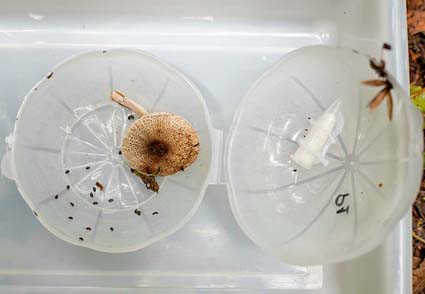Abstract
The shining fungus beetles (Coleoptera: Staphylinidae: Scaphidiinae) comprise more than 1800 described species, which are usually small (≅0.84–14.30 mm long) (Tang et al. 2014 ; Löbl & Ogawa 2016) and found on bracket and resupinate fungi, mushrooms and slime molds (Newton 1984; Löbl & Leschen 2003; Löbl 2018). They are known to be diverse in forests of tropical and subtropical regions, which contrast to the low number of species currently known from Brazil: only 34 species and two subspecies from seven genera (Löbl 2018; von Groll & Lopes-Andrade, 2021). Any active search for Scaphidiinae in the Brazilian Atlantic forest reveals a considerable abundance and diverse of these organisms (pers. obs.), but they disperse rapidly if disturbed, and the success of field collections relies on the collectors’ skills, luck and collecting techniques and devices. The most common methods and devices for collecting shinning fungus beetles are sifting leaf litter, rotten wood and fungi, flight intercept (FIT) and V-flight intercept (V-FIT) traps, aspirators, sweeping, and hand collecting (Löbl & Leschen 2003; Tang et al. 2014; Löbl et al. 2021). Hand collecting is considered the best method, because the host fungi and larvae can be collected together to make associations (Löbl & Leschen 2003).
References
Ashe, J.S. (1984) Description of the larva and pupa of Scaphisoma terminatum Melsh. and the larva of Scaphium castanipes Kirby with notes on their natural history (Coleoptera: Scaphidiidae). The Coleopterists Bulletin, 38, 361–373.
Kurup, V.P., Shen, H.D. & Banerjee, B. (2000) Respiratory fungal allergy. Microbes and infection, 2 (9), 1101–1110. https://doi.org/10.1016/S1286-4579(00)01264-8
Leschen, R.A.B. & Löbl, I. (1995) Phylogeny of Scaphidiinae with redefinition of tribal and generic limits (Coleoptera: Staphylinidae). Revue suisse de Zoologie, 102 (2), 425–474. https://doi.org/10.5962/bhl.part.80472
Löbl, I. (2018) Coleoptera: Staphylinidae: Scaphidiinae. Brill, Leiden, 418 pp. https://doi.org/10.1163/9789004375956
Löbl, I. & Leschen, R.A.B. (2003) Scaphidiinae (Insecta: Coleoptera: Staphylinidae). Fauna of New Zealand, 48, 1–94.
Löbl, I., Leschen, R.A.B & Warner, W.B. (2021) Scaphisomatini of Arizona (Coleoptera, Staphylinidae, Scaphidiinae) collected by V-Flight Intercept traps. Revue suisse de Zoologie, 128 (1), 173–185. https://doi.org/10.35929/RSZ.0043
Löbl, I. & Ogawa, R. (2016) On the Scaphisomatini (Coleoptera, Staphylinidae, Scaphidiinae) of the Philippines, IV: the genera Sapitia Achard and Scaphisoma Leach. Linzer biologische Beiträge, 48 (2), 1339–1492.
Newton, A.F. Jr. (1984) Mycophagy in Staphylinoidea (Coleopetra). In: Wheeler, Q. & Blackwell, M. (Eds.), Fungus/insect relationships. Perspectives in ecology and evolution. Columbia University Press, New York, New York, pp. 302–353.
Tang, L., Li, L.-Z. & He, W.-J. (2014) The genus Scaphidium Olivier in East China (Coleoptera, Staphylinidae, Scaphidiinae). ZooKeys, 403, 47–96. https://doi.org/10.3897/zookeys.403.7220
von Groll, E. & Lopes-Andrade, C. (2021) Scaphisoma pandemum sp. nov. (Coleoptera: Staphylinidae: Scaphidiinae) from the Atlantic Forest of Southeast Brazil. Zootaxa, 4999 (2), 143–156. https://doi.org/10.11646/zootaxa.4999.2.4


